If you're looking to create energizing herbal tea blends, start with a foundational ratio of 2 parts base herb to 1 part complementary herb. For a boost, try mixing green tea with ginseng and lemon balm for a gentle lift, or blend yerba mate, peppermint, and ginger for a robust recharge. Remember to document your ratios because everyone's taste is different, and you might need to adjust based on ingredient strength. Experimenting leads to unique flavors that excite your palate. Keep exploring new combinations to find what energizes you best! There's so much more to discover about blending herbs.
Benefits of Herbal Tea
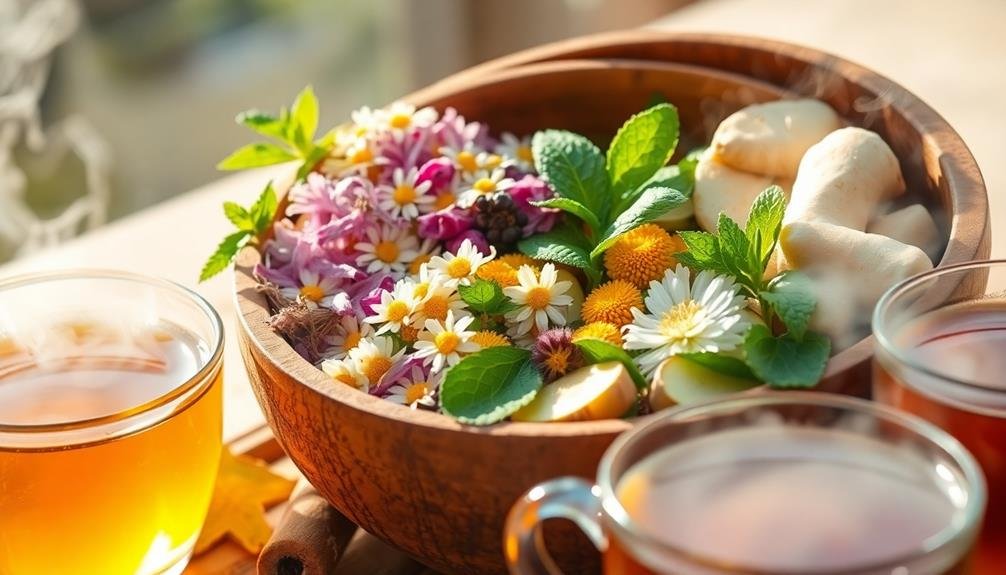
Herbal tea offers a range of benefits that can enhance your well-being. When you sip on a warm cup, you're not just enjoying a comforting drink; you're also nourishing your body and mind. Many herbal teas are packed with antioxidants, which help combat free radicals and reduce oxidative stress. This can lead to improved overall health and a strengthened immune system.
Additionally, herbal teas often possess calming properties. If you've had a stressful day, a cup of chamomile or lavender tea can help soothe your nerves and promote relaxation. You might find it easier to unwind and drift off to sleep after enjoying these blends.
Furthermore, certain herbal teas can aid digestion. Peppermint and ginger teas are well-known for their ability to alleviate stomach discomfort and improve digestion. Drinking these teas after meals can provide relief and enhance your digestive health.
Lastly, incorporating herbal tea into your daily routine can encourage mindfulness. Taking a moment to brew and enjoy your tea allows you to pause and appreciate the present, fostering a sense of peace.
Essential Ingredients for Energy
When you're looking for a boost, certain herbs can energize your day.
Let's explore key energy herbs and their nutritional profiles, so you can choose the best blends for your needs.
Understanding these ingredients helps you make informed decisions about your herbal tea.
Key Energy Herbs
If you're looking to boost your energy levels naturally, incorporating key energy herbs into your daily routine can make a significant difference. These herbs not only enhance your liveliness but also support your overall wellness.
One standout herb is ginseng, known for its ability to improve stamina and reduce fatigue. Adding ginseng to your herbal tea can provide that much-needed lift during your day.
Another powerful option is ashwagandha, an adaptogen that helps your body manage stress, leading to increased energy levels.
Don't overlook green tea, either. It's packed with caffeine and antioxidants, offering a gentle energy boost without the jitters.
Peppermint is another fantastic choice; its invigorating aroma can awaken your senses and refresh your mind.
Lastly, consider yerba mate. This South American herb has a unique blend of caffeine and nutrients that can enhance your focus and endurance.
Nutritional Profiles Explained
Understanding the nutritional profiles of essential ingredients for energy can help you choose the right components for your herbal tea blends. Each herb offers unique benefits that can greatly impact your energy levels.
For instance, ginseng is renowned for its adaptogenic properties, boosting stamina and reducing fatigue. It's rich in ginsenosides, which are believed to enhance physical performance.
Another excellent choice is matcha, packed with L-theanine and antioxidants. This green tea powder not only provides a steady caffeine boost but also promotes mental clarity without the jitters.
When combined with ginger, you gain an anti-inflammatory kick that can improve circulation and support digestion, further enhancing your energy.
Don't overlook peppermint, either. Its invigorating aroma can stimulate your senses and increase alertness, thanks to its menthol content.
Understanding Herbal Tea Ratios
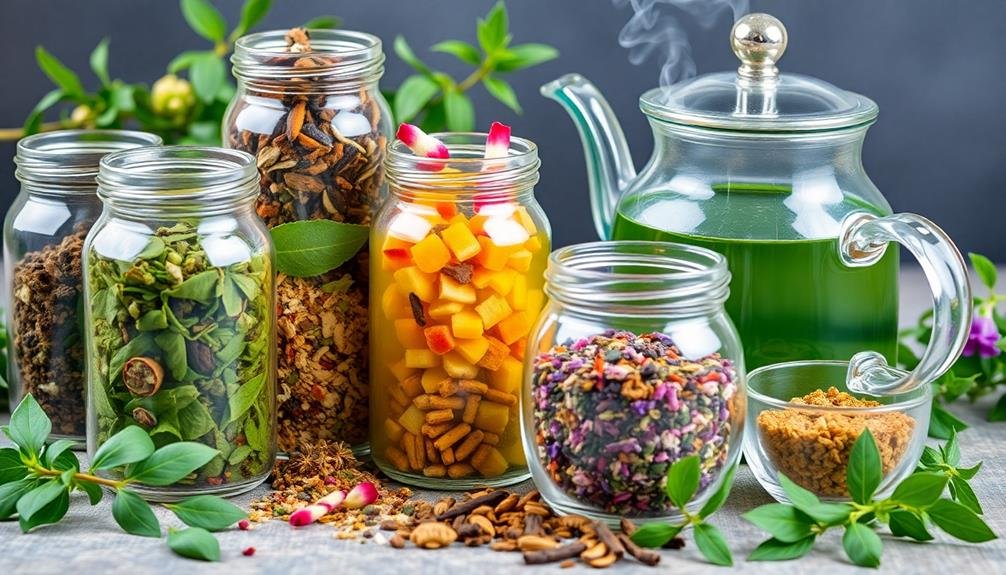
Getting the right herbal tea ratios can make all the difference between a delightful brew and a lackluster cup. When you're blending herbs, it's crucial to strike a balance that highlights each ingredient's unique qualities. Start with a foundational ratio of two parts base herb to one part complementary herb. This ratio allows the primary flavor to shine while enhancing it with secondary notes.
You'll want to take into account the potency of each herb, too. Some herbs, like peppermint, can easily overpower gentler flavors like chamomile. In such cases, adjust the ratio to one part peppermint and two parts chamomile.
If you're working with dried herbs, remember they're more concentrated than fresh ones, so you may need to tweak the amounts accordingly.
When experimenting, take notes on your blends. You might discover a winning combination with a one-to-one ratio or even equal parts of multiple herbs. The key is to taste as you go, adjusting the proportions until you find your perfect blend.
Popular Energizing Herbs
Many people turn to herbal teas for a natural energy boost, and certain herbs stand out for their invigorating properties. One of the most popular is ginseng, known for its ability to enhance stamina and reduce fatigue. It's a favorite among those looking for a mental lift, too.
Another energizing herb is yerba maté, packed with caffeine and antioxidants, providing a smooth energy increase without the jitters. If you prefer something less intense, try rooibos; while caffeine-free, it's rich in minerals that can help you feel more alert.
Peppermint is another excellent choice, offering a revitalizing flavor and a natural energy lift. Its aroma alone can help improve focus and mental clarity.
Ginger, with its spicy kick, not only aids digestion but also boosts circulation, lending you an extra pep in your step. Finally, don't overlook green tea, which combines moderate caffeine levels with L-theanine, promoting a calm yet alert state.
Experimenting with these herbs can help you discover what energizes you best. By understanding their unique properties, you can tailor your herbal tea experience for maximum energy.
Crafting Your Blend
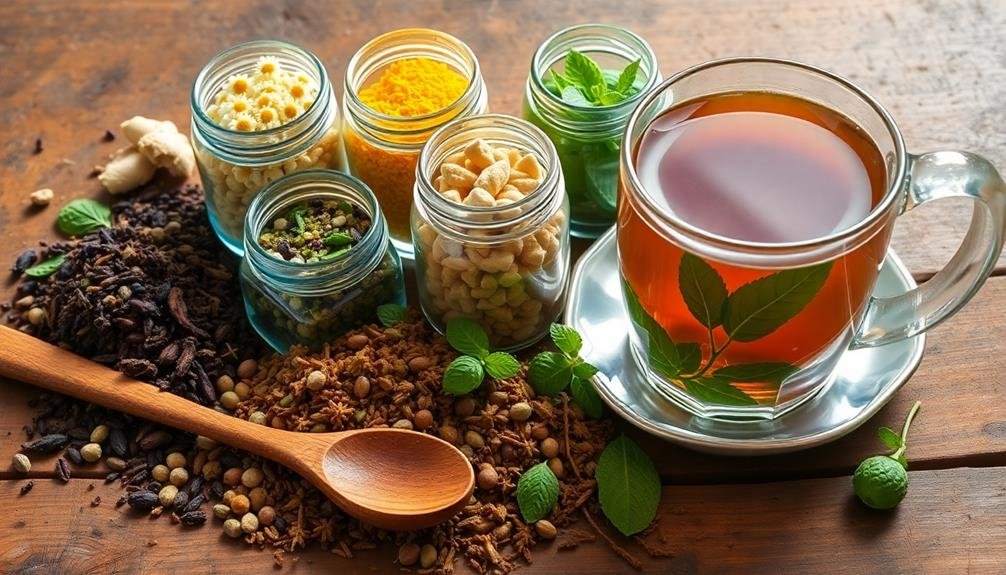
Creating your own herbal tea blend can be a fun and rewarding experience, allowing you to customize flavors and benefits that suit your preferences. Start by selecting a base herb, like chamomile or peppermint, then layer in other herbs for added flavor and effects. Think about what you want to achieve—do you need energy, relaxation, or a boost to your immune system?
Here's a simple table to inspire your blend choices:
| Herb | Flavor Profile |
|---|---|
| Peppermint | Cool, invigorating |
| Ginger | Spicy, warming |
| Lemon Balm | Light, citrusy |
| Hibiscus | Tart, fruity |
Experiment with ratios! A great starting point is 1 part base herb to 1 part flavor herb. Adjust according to your taste preferences; you might prefer more ginger for warmth or hibiscus for tartness. Don't shy away from jotting down your ratios and notes. You can refine your blend over time, making it truly your own. Immerse yourself in this creative process, and soon you'll have a personalized tea that not only tastes great but also supports your wellness goals.
Sample Blends for Energy
Looking to boost your energy levels? You can try these invigorating herbal tea blends that pack a punch.
One popular mix is green tea, ginseng, and lemon balm. The green tea provides a gentle caffeine lift, while ginseng enhances stamina and focus. Lemon balm adds a rejuvenating touch, helping to calm your mind.
Another fantastic blend is yerba mate, peppermint, and ginger. Yerba mate is known for its robust energy-boosting properties, while peppermint invigorates your senses. Ginger adds a spicy kick and supports digestion, making this blend not just energizing but also revitalizing.
If you prefer a caffeine-free option, consider combining hibiscus, rose hips, and cinnamon. Hibiscus offers a tart flavor and a wealth of antioxidants, while rose hips are rich in vitamin C, giving your immune system a boost. Cinnamon adds warmth and a hint of sweetness, making this blend comforting and energizing.
You can also experiment with chai spices mixed with black tea for a rich, flavorful boost.
Each of these blends not only energizes but also delights your taste buds, ensuring you feel revitalized and ready to tackle your day.
Techniques for Mixing
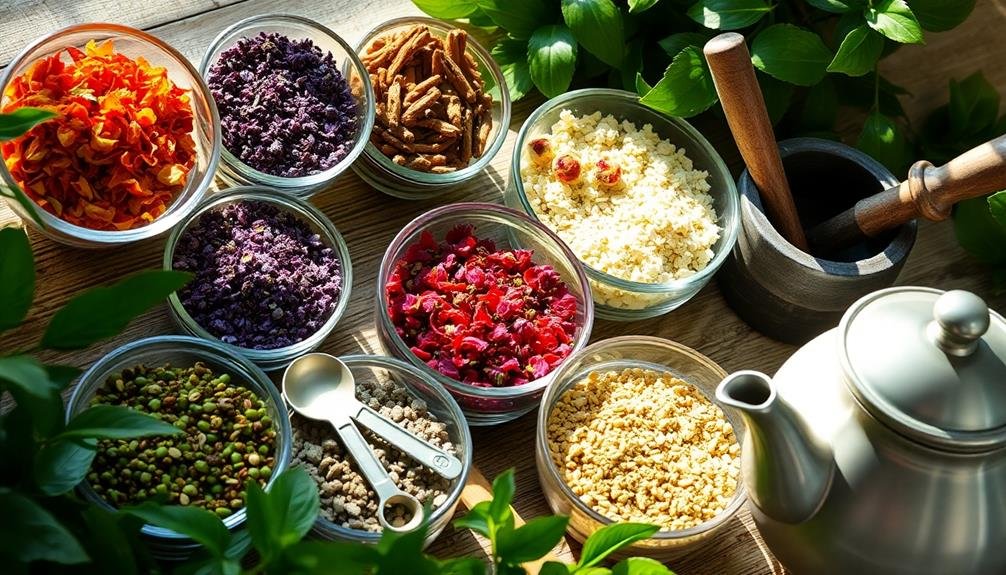
Mixing your own herbal tea blends can be a delightful and creative experience. To start, gather fresh or dried herbs that resonate with your taste and desired effects. When you combine these ingredients, consider their flavors and properties. For instance, if you want a revitalizing blend, mix peppermint with lemongrass. For a calming effect, combine chamomile with lavender.
Next, use a scale or measuring spoons for precision. A common ratio is one part of each herb, but feel free to adjust based on preference. If you're experimenting, begin with small batches. This way, you can refine your blend without wasting ingredients.
When mixing, crush or chop herbs to release their essential oils, enhancing the aroma and flavor. You can also layer the herbs in a jar, creating visual appeal while ensuring an even distribution.
Don't forget to take notes on your combinations and ratios; this'll help you recreate your favorites.
Lastly, trust your palate! Tasting your blend before brewing helps you adjust flavors. Mixing herbal teas is all about exploration and finding the perfect balance that excites your senses. Enjoy the journey!
Brewing Tips for Maximum Flavor
How can you guarantee that your herbal tea blends reach their full flavor potential? With a few simple brewing techniques, you can elevate your tea experience. Follow these tips to reveal the rich, vibrant flavors of your herbal blends:
- Water Temperature: Use water that's around 200°F (93°C) for most herbal teas. Too hot, and you risk bitterness; too cool, and you won't extract the full flavor.
- Steeping Time: Allow your tea to steep for 5 to 7 minutes. This duration helps to confirm that the herbs release their essential oils and flavors, creating a more aromatic cup.
- Quality Ingredients: Choose high-quality, fresh herbs. The better the ingredients, the more robust the flavor. Don't skimp on quality if you want that invigorating taste.
- Proper Ratios: Use the right blend ratios. A good rule is 1 teaspoon of dried herbs per cup of water. Adjust according to your taste preferences, but don't go overboard!
Storing Your Herbal Teas
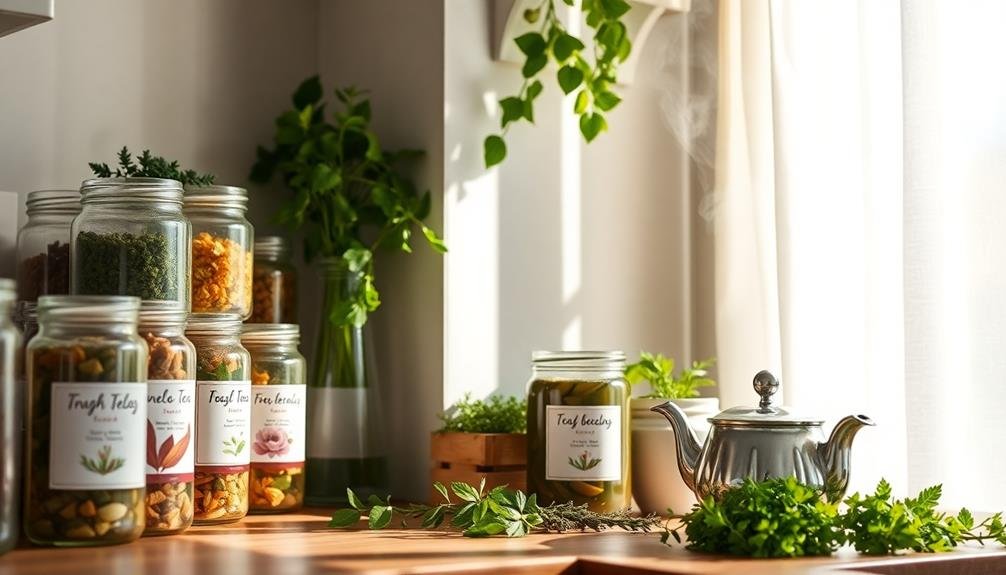
Properly storing your herbal teas is essential to preserve their flavor and potency. To maintain their freshness, choose an airtight container made of glass, metal, or ceramic. Avoid plastic, as it can absorb odors and chemicals that might alter the tea's taste.
Keep your teas in a cool, dark place, away from moisture, heat, and light. A pantry or cupboard works well. Proper storage can greatly extend the shelf life of your blends, allowing you to enjoy their energizing properties for longer.
Here's a simple guide to help you store your herbal teas effectively:
| Storage Method | Ideal Conditions | Shelf Life |
|---|---|---|
| Airtight Container | Cool, dark place | 6-12 months |
| Glass Jars | Away from sunlight | 12-24 months |
| Metal Tins | Dry environment | 6-12 months |
| Ziplock Bags | Cool, dry area | 3-6 months |
| Paper Bags | Not recommended | 1-3 months |
Adjusting Ratios for Taste
After ensuring your herbal teas are stored correctly, the next step is to fine-tune the flavor by adjusting the ratios of your ingredients. Finding the right balance can elevate your tea experience, making it more enjoyable and invigorating.
Don't be afraid to experiment; tweaking the ratios can lead to delightful surprises.
Here are four tips to guide you in adjusting your herbal tea blends for ideal taste:
- Start Small: Increase or decrease one ingredient at a time to see how it affects the overall flavor. This way, you'll pinpoint the changes that resonate with your palate.
- Consider Strength: If a particular herb is overpowering, reduce its ratio. Conversely, if you want more punch, add a bit more of the stronger ingredient.
- Balance Flavors: Aim for harmony between sweet, bitter, and earthy notes. A balanced tea will be more satisfying and rejuvenating.
- Keep It Fresh: Always taste your blend after adjustments. Fresh ingredients might require different ratios than dried ones, so trust your senses!
Adjusting ratios can transform your tea into a personal masterpiece, so have fun with it!
Experimenting With New Ingredients
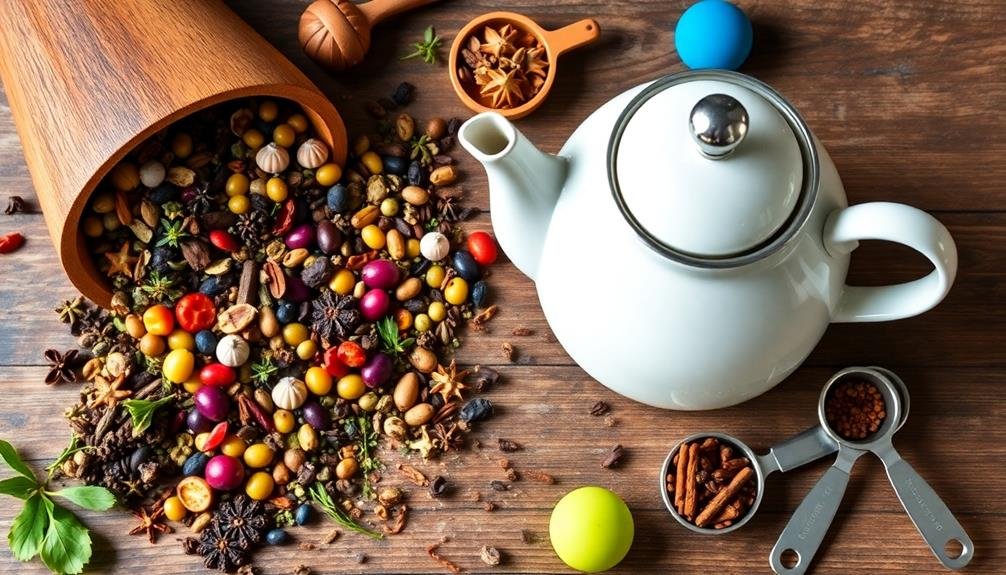
Exploring new ingredients can greatly enhance your herbal tea blends, opening up a world of flavors and aromas. Don't be afraid to step outside your comfort zone. Think about incorporating herbs, spices, or fruits that you mightn't typically consider.
For instance, adding a pinch of ginger can provide a warming kick, while a few slices of fresh citrus can brighten your blend.
Consider experimenting with adaptogens like ashwagandha or reishi mushroom. These not only add unique flavors but also provide additional health benefits. When trying new ingredients, start with small amounts to gauge how they influence the overall taste. You can always adjust the ratios later.
Another fun approach is to create seasonal blends. In the fall, think of chai-inspired spices like cardamom and cloves, while summer might call for revitalizing mint or hibiscus.
Remember, the key is balance—ensure that no single ingredient overpowers the others.
Keep notes on your experiments so you can recreate your favorites later. With each new blend, you'll gain confidence and discover delightful combinations that energize your tea-drinking experience!
Enhancing Your Tea Experience
To truly enhance your tea experience, start by choosing quality ingredients that can elevate the flavor profile.
Next, pay attention to your brewing techniques, as the right temperature and steeping time can make all the difference.
Choosing Quality Ingredients
When you choose quality ingredients for your herbal tea blends, you're not just enhancing the flavor; you're also elevating the entire tea-drinking experience.
Quality herbs, spices, and fruits can make all the difference, transforming your simple brew into a delightful ritual that nurtures your body and soul.
Here are four key factors to take into account when selecting your ingredients:
- Freshness: Fresh herbs release more essential oils, providing a vibrant flavor and aroma that dried ones simply can't match.
- Organic Options: Choosing organic guarantees you're sipping on a product free from harmful pesticides, giving you peace of mind along with a better taste.
- Sourcing: Know where your ingredients come from. Locally sourced or ethically harvested ingredients often have superior quality and support sustainable practices.
- Variety: Don't shy away from exploring different herbs and spices. Unique combinations can awaken your senses, creating a truly memorable tea experience.
Brewing Techniques Matter
Brewing techniques can considerably elevate your tea experience, transforming a simple cup into a moment of tranquility.
Start by selecting the right water. Use filtered or spring water to avoid any unwanted flavors that tap water might introduce. Heat the water to the ideal temperature for your herbal blend—most herbal teas thrive at around 200°F (93°C).
Next, pay attention to steeping time. Generally, a steeping period of 5 to 10 minutes will release the full spectrum of flavors and benefits from your herbs. If you steep too briefly, you might miss out on the tea's potential; steeping too long can result in bitterness.
Consider using a tea infuser or a teapot with a built-in strainer to allow for proper expansion of the herbs. This guarantees you're extracting maximum flavor without any gritty residue.
Flavor Pairing Tips
Harmonizing flavors can transform your herbal tea experience into a delightful journey for your palate. By thoughtfully pairing ingredients, you can enhance each sip and create a symphony of tastes. Here are some tips to elevate your herbal tea blends:
- Sweet & Spicy: Combine chamomile with a hint of ginger for a soothing yet invigorating flavor. The sweetness of chamomile balances the warmth of ginger beautifully.
- Citrus & Herbaceous: Mix lemon verbena with mint to achieve a revitalizing burst of flavor. The zesty notes brighten the herbal base, making it perfect for any time of day.
- Floral & Earthy: Pair hibiscus with rooibos to create a rich, deep brew. The tartness of hibiscus complements the natural sweetness of rooibos, giving you a full-bodied experience.
- Fruity & Creamy: Blend chamomile with a touch of vanilla for a calming yet indulgent treat. The creamy notes of vanilla enhance the floral essence, creating a comforting cup.
Experiment with these combinations to find your perfect blend, and let your herbal tea elevate your senses!
Frequently Asked Questions
Can I Use Dried Herbs Instead of Fresh for My Tea Blends?
Yes, you can use dried herbs instead of fresh for your tea blends. Just remember, dried herbs are more concentrated, so you'll need less. Experiment to find the right balance for your perfect brew!
How Long Do Herbal Tea Blends Stay Fresh When Stored Properly?
When stored properly in a cool, dark place, your herbal tea blends can stay fresh for about six months to a year. Just make sure they're sealed tightly to maintain their flavor and potency.
Are There Any Caffeine-Free Options for Energizing Herbal Teas?
Absolutely, you can enjoy caffeine-free energizing herbal teas! Options like rooibos, ginseng, or peppermint provide a natural boost without caffeine. Experiment with different blends to find your perfect energizing yet soothing cup. Enjoy!
Can I Mix Energizing Herbs With Other Types of Tea?
Yes, you can mix energizing herbs with other types of tea. Combining different flavors enhances your experience, allowing you to enjoy unique blends tailored to your taste while reaping the benefits of each ingredient.
What Is the Best Time of Day to Drink Energizing Herbal Tea?
The best time to drink energizing herbal tea is in the morning or early afternoon. You'll boost your energy levels and stay alert throughout the day. Just avoid it too close to bedtime to guarantee restful sleep.
In Summary
Now that you know the benefits of energizing herbal tea blends and how to craft your perfect mix, it's time to experiment! Play around with different ratios and ingredients to find what suits your taste best. Remember, the right blend can elevate your energy and enhance your overall experience. So grab your favorite herbs, start mixing, and enjoy the delightful journey of discovering your ideal herbal tea. Cheers to your new invigorating ritual!


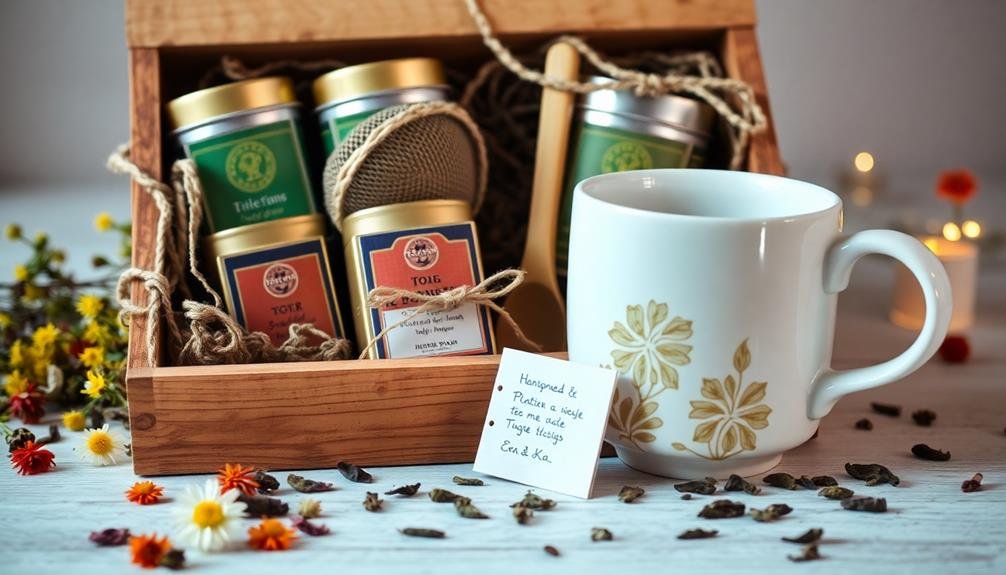
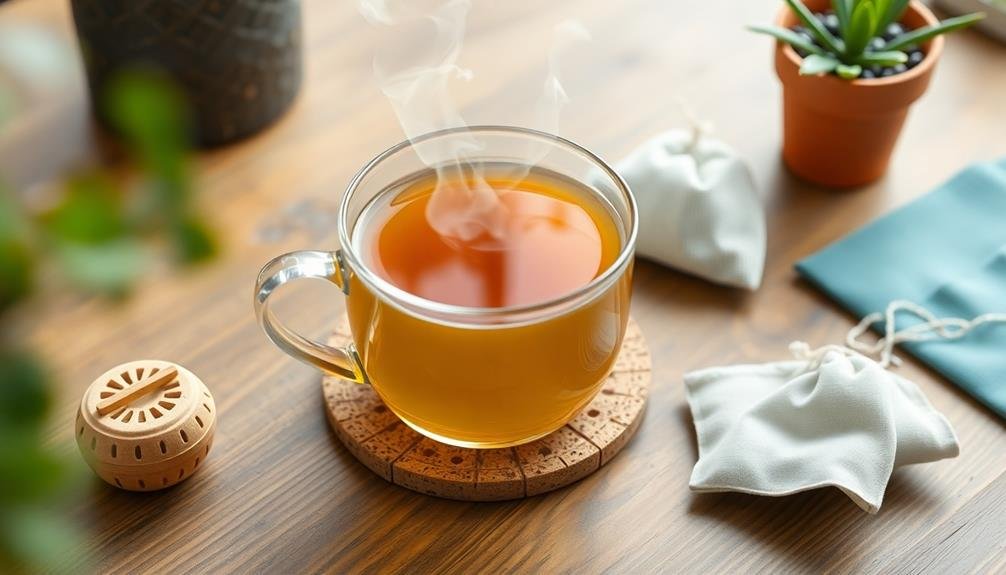
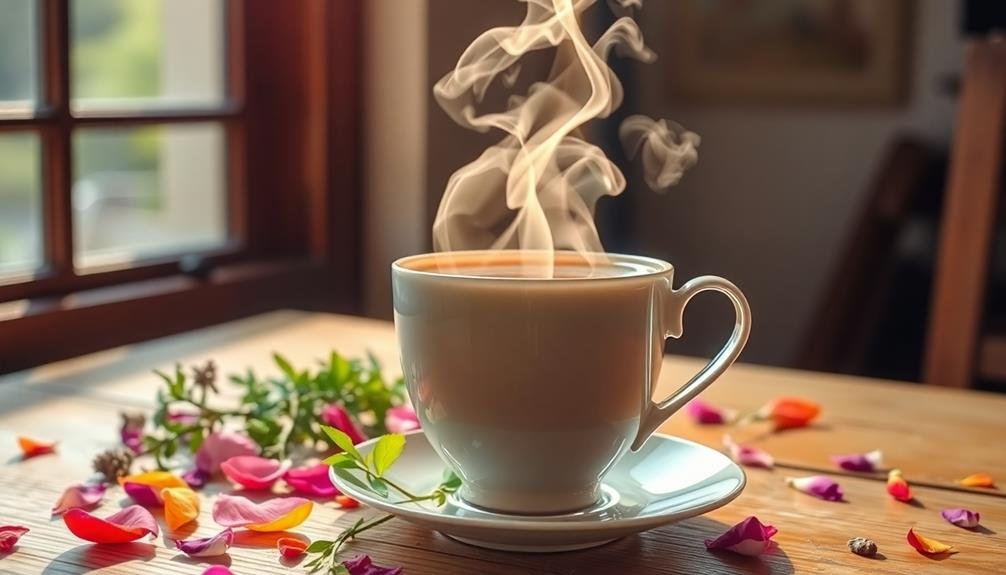
Leave a Reply